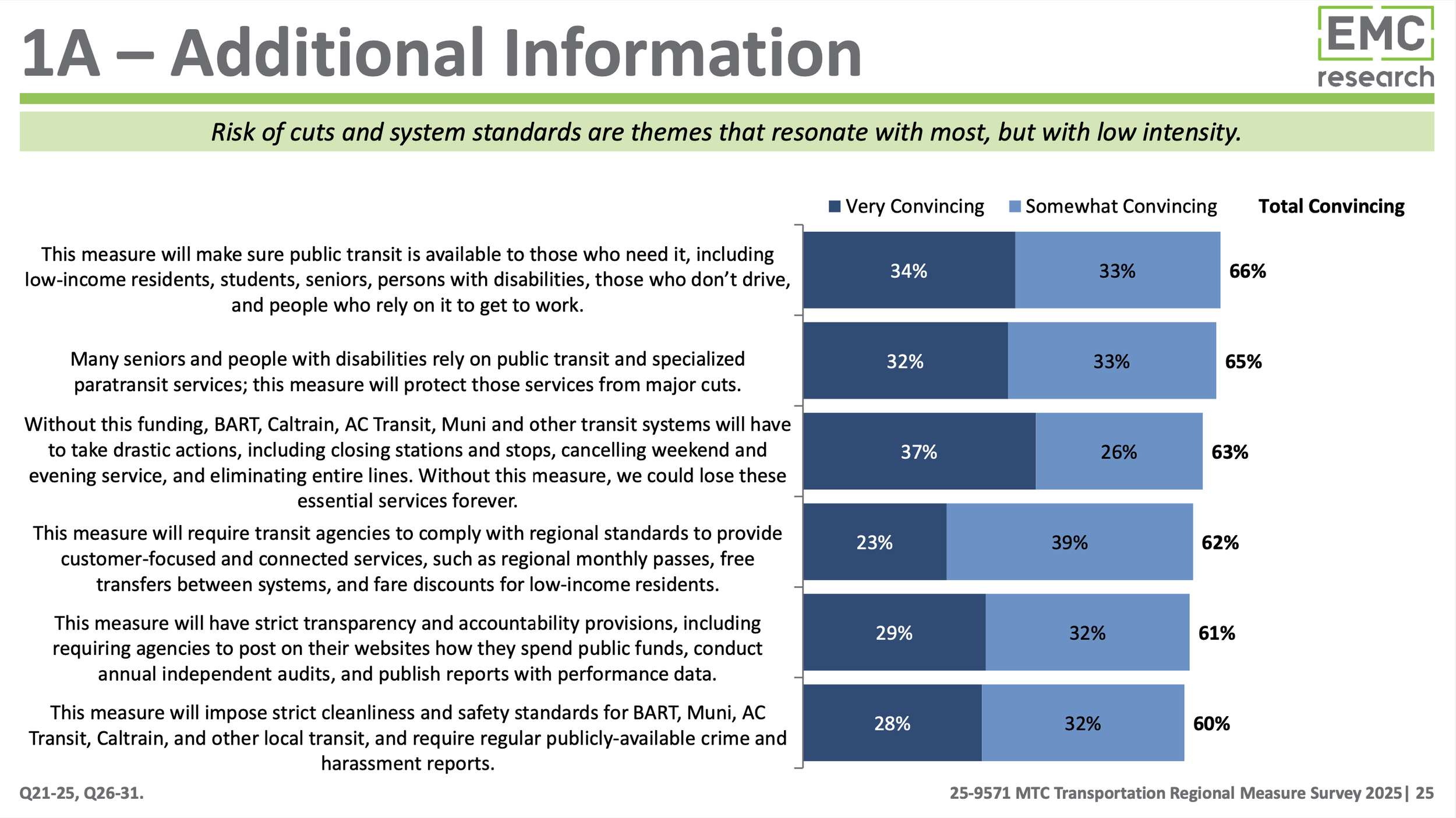Bay Area transit poll shows promise and potential solutions to the transit funding puzzle
Polling about a potential regional transportation funding measure conducted by MTC showed results that could pass with a citizens’ signature gathering effort, and the mood of Bay Area lifting somewhat. Voters continue to value an improved system more than just stemming cuts. The polls left open questions that will be debated by MTC and the legislature.
All of the options polled better than 50% which is the threshold needed to pass a measure with a citizens’ signature gathering effort. None of the options reached the two-thirds threshold that would be needed if a government agency puts a measure on the ballot.
Consistent with previous polls, voters continue to support public transit - and to value improvements more highly than stemming cults to service. Also consistent with previous polls, voters highly value fixing potholes on local streets.
Polling by county
Fortunately, a poll option to charge a higher rate in San Francisco polled relatively well, since San Francisco faces the deepest challenges since it is served by Muni, BART and Caltrain which are all facing fiscal cliffs and looming cuts.
In contrast to insider conventional wisdom, San Mateo County polled relatively well; some board members and MTC commissioners had speculated that San Mateo County residents would not support funding all the agencies that serve the county.
Voter sentiment improving
The mood of voters was still pessimistic, but pessimism and opposition to taxes have improved since a nadir a few years ago.
Communication opportunities
The poll showed that about two thirds of voters in the core four counties use transit at least some of the time. Because of this, notable improvements such as Caltrain electrification, and upcoming free transfers and open payments, create opportunities to improve voter confidence. And bad news such as Muni cuts risk decreasing voter perception.
Voters continue to value making transit available for people who depend on transit including seniors, people with disabilities, and people with low incomes. This supports funding formulas that support Muni and AC Transit which serve many people who depend on transit, and is a case against funding formulas based on fares. The relatively strong results from Alameda county bolster this case, since Alameda County voters seem less likely to vote for a measure that would result in steep AC Transit cuts.
Not surprisingly, seamless transit continues to poll well, with voters supporting coordinating initiatives such as regional passes, free transfers, and discounts for low-income riders. But expressing these improvements in terms of compliance with regional standards polls less well than expressing it in terms of rider benefits as in some earlier polls.
The strongest argument against a tax focuses on cost of living - this highlights an opportunity to communicate how public transit reduces costs for transportation which is the second highest household costs, and helps reduce costs for housing. A poll question about housing near transit polled less well than other benefits - it would be valuable to make the affordability connection directly.
Another strong argument against a tax is that the measure may not improve the transit system or prevent cuts. It is critical that the measure and overall funding strategy improve the system.
Decisions and puzzle piece strategies
The poll will inform debates about debates and strategies, at MTC and at the legislature.
Voters want to see improvements, but the amount of funds raised by the options in the poll will not be enough to meet the goals of voters - or the region, or the state. The situation is most dire in San Francisco. In the same legislative session, the legislature will be considering some options for the state to also support public transit. The state of California has chronically underfunded transit operations.
A layered strategy providing funding at the state, regional, and in some cases local level will be needed to deliver the service and outcomes that voters want.
Some parts of the region, notably Santa Clara County (SCC) have stated clearly that they prefer to cooperate with a regional measure side-by-side, by doing a local measure that contributes to the regional services supporting the county, BART and Caltrain, and contributing to regional transit coordination, providing a “puzzle piece” that snaps together with a multi-county measure. Santa Clara will need to do their own polling to verify whether their intuition that voters would prefer a local measure.
Some San Mateo County (SMC) leaders have expressed preference for a separate strategy as well. SMC would also need to do separate polling to verify this intuition. Given the current poll which shows solid majority support in SMC for solutions that keep the entire transit system running, it would seem like a “puzzle piece” strategy promoted by SCC leaders could also meet voter desires. And it would seem like political vulnerability to promote options that would lead to cuts to parts of the system serving SMC. To put it bluntly, these poll results show that SMC residents don’t want to cut BART service.
The lowest polling results were seen in the four North Bay Counties at 44% - lower than previous polls. However, the margin of error is high at 6.9%. More work is needed to drill into voter desires. Questions for the North Bay including whether it makes sense for all or part of the North Bay to create a separate “puzzle piece” measure that also contributes to transit coordination. Some North Bay leaders have been exploring a measure for SMART, with a sales tax expiring in 2029. The North Bay should also be testing the importance of a subregional measure serving seniors, people with disabilities, and better system coordination, by supporting multiple agencies, not just SMART.
We will keep you posted on the upcoming opportunities to take action to fund saving and improving transit at the region and state level.







